- What's the benefit to the CEO?
- What does SEO include?
- Stages of SEO-promotion
- Analyze a niche and conduct a seo audit of your competitors. Who are they and how are they promoted online?
- Technical seo-audit: identification of technical problems
- Semantic kernel compilation: selection of key queries
- Preparing a draft site structure for better navigation and indexing
- Filling pages with content: creating unique and valuable materials
- Internal relinking: linking between pages
- External optimization: strategies for gaining external links and authority
- Analytics. How to track the result of the work. What tools and reports are available
- Types of SEO optimization
- Types of approaches to SEO by degree of legality: white, gray and black optimization
- Criteria for success of SEO promotion
- What results should you expect from SEO? Timeframe to reach Google top 10
- Interested in how much does it cost SEO to promote a website to the top 10?
- How does AI help in seo promotion?
- Conclusions
- FAQ
In simple words, SEO is the optimization of content and technical parameters of the site to improve its visibility in search engines. The goal of SEO is to increase your site's position in search engine results for keywords popular with the target audience*.
*Target audience - a group of people united by common attributes, goals and objectives. For example, Apple customers are ambitious young and middle-aged people with a relatively high level of income. They often try to impress others with a prestigious gadget.
Initially, all SEO promotion is aimed at attracting maximum traffic. The more visitors you have, the higher the probability that one of them will buy a product, order a service or transfer money for an infoproduct.
Here's what the experts at Google have to say about search engine optimization and SEO promotion services.
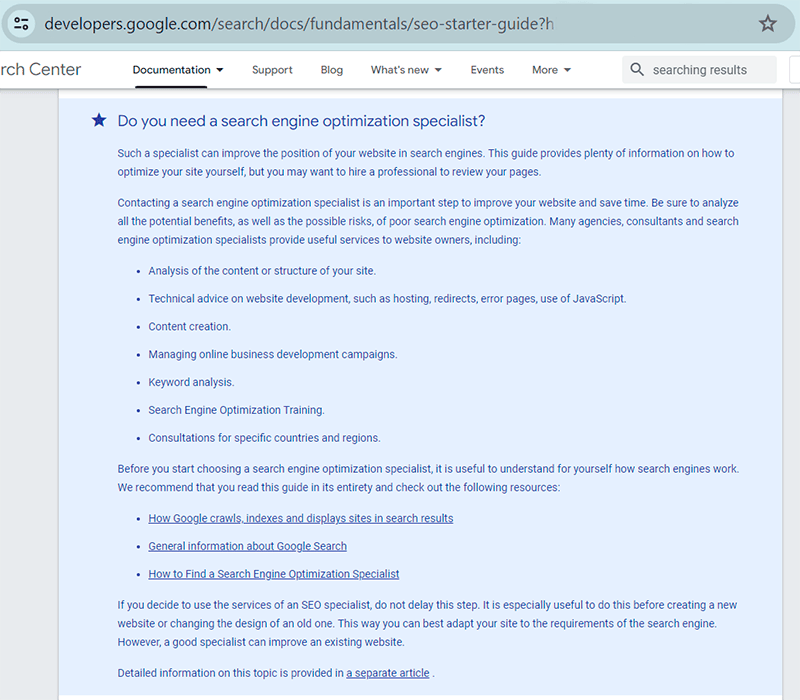
Let's familiarize ourselves with what famous seo experts and popular resources say about what SEO is:
«Search Engine Optimization - is a process that is designed to make the structure of a website and its content more accessible and understandable to search engines. You may also come across the acronym SEO (Search Engine Optimization). For example, an SEO specialist is a search engine optimization specialist.»
developers.google.com
«SEO is the art and science of optimizing your website to achieve high positions in search engine results.»
backlinko.com
«At the heart of CEO is understanding how search algorithms work and applying that knowledge to create quality content and optimize the technical aspects of a website.»
Author: Rand Fishkin, founder of Moz
«SEO is an ongoing process that requires constant monitoring, analyzing data, and adapting to changes in search algorithms.»
Google developers
«Google controls 92% of the search engine market share worldwide. This includes 72% of the desktop market and 92% of the mobile search engine market.»
blog.hubspot.com
What's the benefit to the CEO?
This question is best answered by numbers. We've compiled some interesting statistics for you, let's go....
Interesting Facts:
«When Google opened its proverbial doors in September 1998, it only had an average of about 10,000 searches per day.»
blog.hubspot.com
«As of April 2023, Google has about 83.9 billion users worldwide.»
www.statista.com
«Nearly a quarter of web professionals surveyed said their primary source of web traffic is direct traffic, followed by organic and then social.»
blog.hubspot.com
«Google does not disclose search volume data. However, it is estimated that Google processes about 99,000 searches every second, which equates to 8.5 billion searches per day and about 2 trillion global searches per year. The average person conducts three to four searches each day.»
blog.hubspot.com
«The average price per click on Google Ads in 2023 will be $4.22 across all industries.»
www.wordstream.com
And here at last is the very benefit.....
Let's compare how the value of a user from the Search Traffic channel changes. In the graph below, you can see when and how the cost of an engaged visitor drops depending on how many key queries make it to the top of the search results.
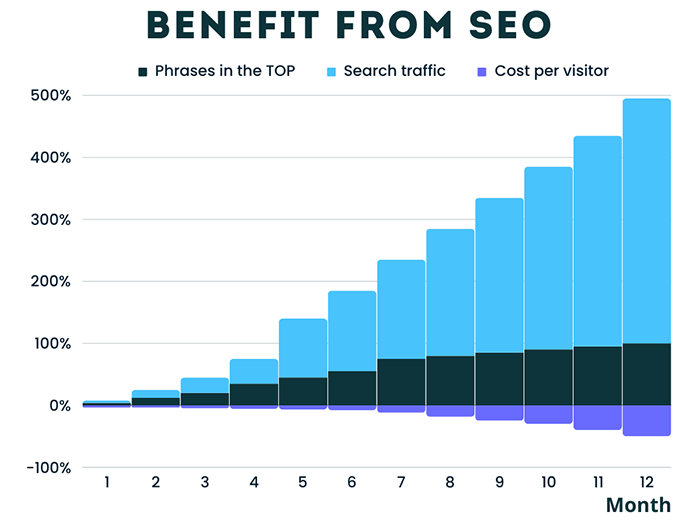
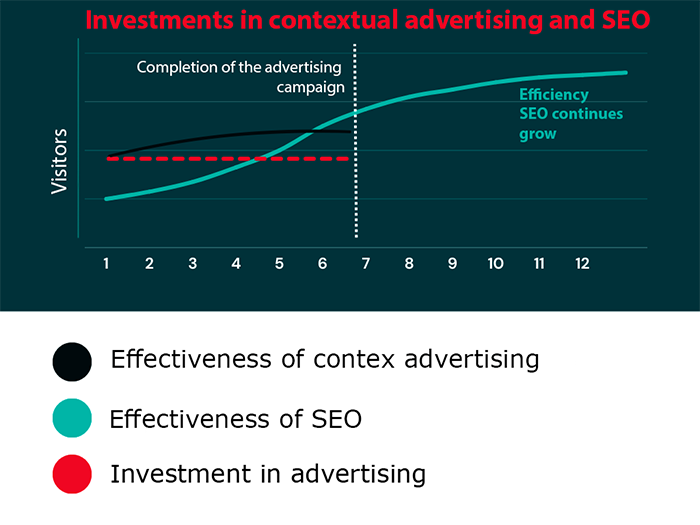
As you can see with the help of SEO promotion there is an opportunity to reduce the cost of the attracted visitor by 50% or more from the cost of this indicator at the beginning of the project launch.
The most popular requests in Ukraine for 2022 - 2023.
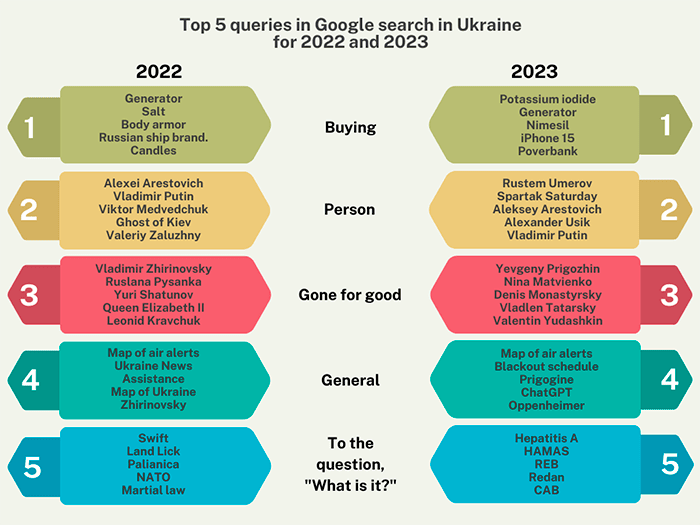
«Studies have shown that getting to the first position in the search engine increases the CTR (clickability rate) to 39.8%. This drops to 18.7% for second position and 10.2% for third position. As you can see, that's a HUGE difference.»
backlinko.com

«53% of internet users pre-study product information before making their choice.»
www.thinkwithgoogle.com

More than half of vacation shoppers plan to compare prices online to find a bargain.
Since mid-August, there has been an increase in interest in Black Friday and Cyber Monday offers, marked by an average weekly increase in search volume of 15%.
Since the beginning of September, there has been an average increase in the use of keywords related to product research, such as "reviews," "specs" and "unboxing," by an average of 30%.
Getting inexpensive bids compared to other traffic acquisition channels is the most coveted goal for businesses, but that's not all the benefits of SEO, is it?
The main goal of SEO promotion is to improve the visibility of the site in search engines, to increase positions on the most important keywords to maximize the volume of incoming traffic.
While working on this task the SEO specialist is also working on:
- Improved reputation - if users and search engines trust the Internet resource, it is easier for it to fulfill its commercial and non-commercial tasks;
- Increased recognition - the more people see and know the brand, company, product, the easier and more often they choose your offer;
- increase in conversions - for example, conversion to purchase if you sell iPhone cases or conversion to registration if you promote events - a competent CEO can increase the conversion rate of any targeted action;
- increase in the volume of traffic - the number of visitors directly depends on it, which means the number of new potential customers and buyers;
- increased visibility in search engines - when the site is on the first page of the output, all seo-indicators begin to grow rapidly, as well as significantly boost the sale of goods, services or infoproducts online.
In order to achieve such results, it is important to clearly understand what elements of SEO consists of and in which areas it is worthwhile to make the main optimization efforts.
Ready to get selling site / advertising / branding?
Projected
Systemic
Stable
Sales
via the Internet

What does SEO include?
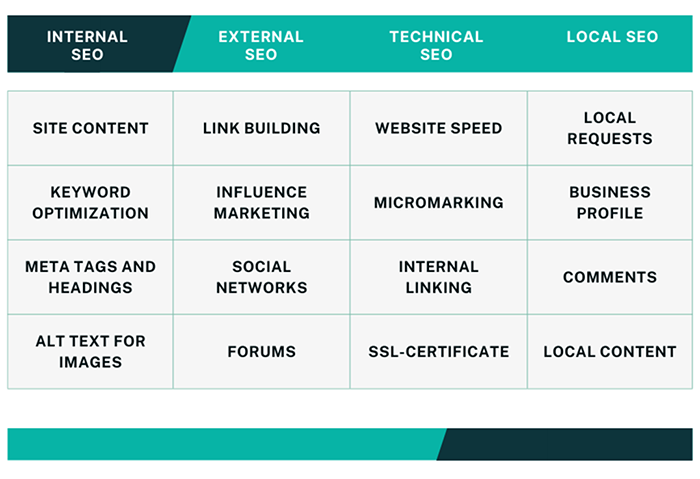
Interesting Facts:
«Search engine optimization involves various elements such as internal and external CEO, technical CEO and local CEO. They are all important parts of SEO that ultimately help your site get more traffic and rankings.»
https://backlinko.com
All CEO activities can be conditionally divided into internal and external optimization.
Internal optimization is needed to eliminate technical errors and fill the resource with content that meets the interests and requests of future visitors.
«Page headlines with a question have a CTR 15% higher than regular headlines.»
HubSpot
In addition, it is necessary to link the main internal pages, provide convenience and ease of user interaction with the site, as well as to fulfill the seo-recommendations of search engines regarding text content and images. The latter is especially important for commercial resources.
«19% of Google searches contain images.»
HubSpot
External optimization is all the work of promotion in search engines, namely improving reputation, developing social networks, placing links from other trusted sites.
So where to start? What work is being done on the project to bring it to the top 10?
Stages of SEO-promotion
Search engine seo promotion consists of many stages. Each next stage is a logical continuation of the previous one, but in terms of priority level in SEO, each of them is of equal importance.
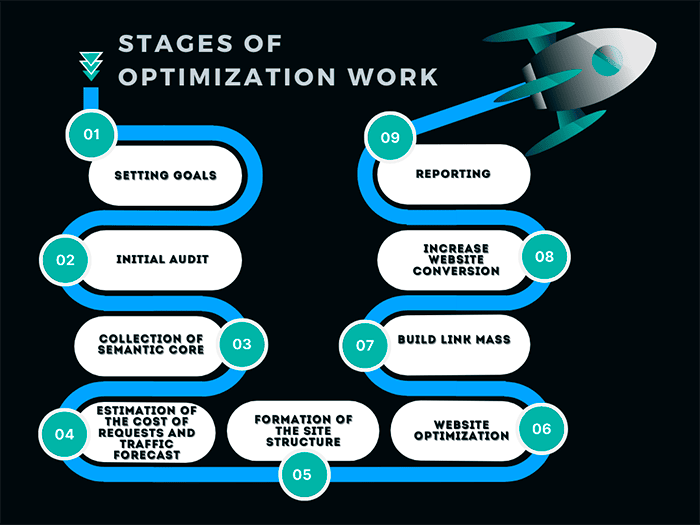
The process of promotion to the top includes several stages, but its achievement does not mean that seo specialists stop working. Search engine algorithms are always improving and to keep and achieve better results, you need to adjust in time to the new changes that dictate, including your competitors. To be above the competition, you must constantly work on the content and development of the site, making it convenient and interesting for users.
Analyze a niche and conduct a seo audit of your competitors. Who are they and how are they promoted online?
Interesting Facts:
«Your search engine competitors may be different from your regular offline competitors.»
https://backlinko.com
Competitor SEO analysis is the process of evaluating and analyzing your competitors' websites to gain valuable information about their search engine seo-optimization strategies.
Example of a plan for conducting the analysis:
- Gather a list of competitors;
- Collect data on key indicators of site quality:
- traffic sources and volume;
- domain authority;
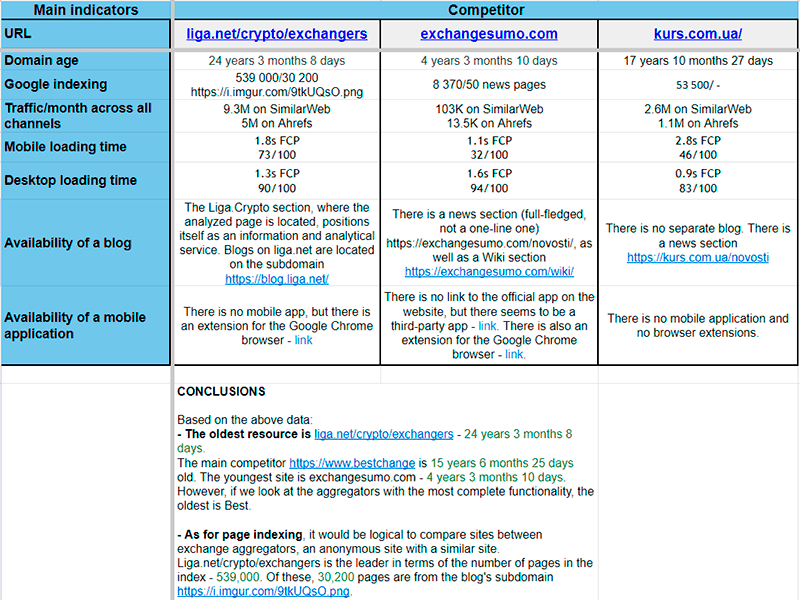
- sources of obtaining reference mass;
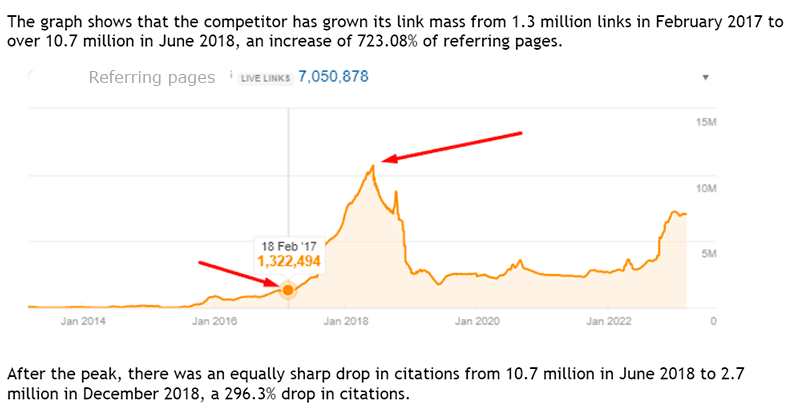
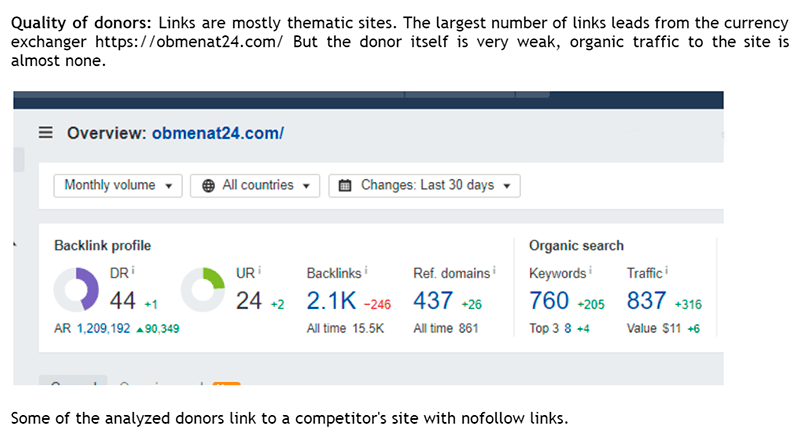
- number of pages in the index, etc.
- Analyze the queries your competitors are ranking for;
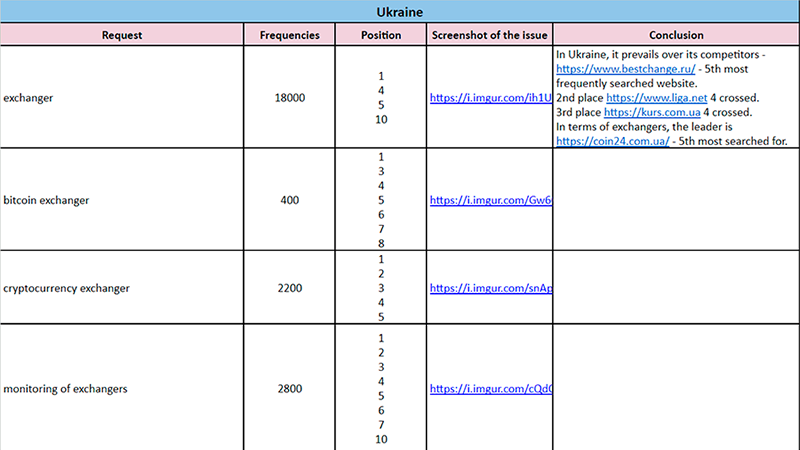
- Research the structure of competitors' websites;
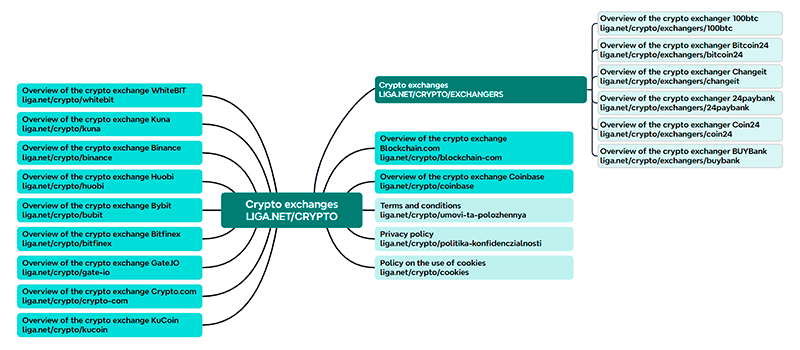
- Do a content analysis;

- Study the features and «tricks» that the competitor uses on the site;
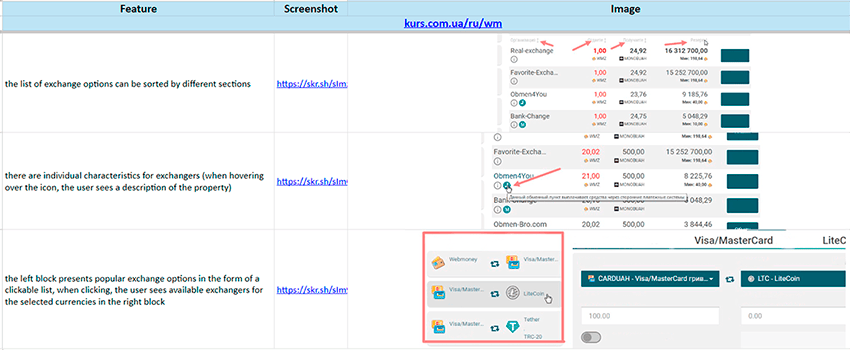
- Add checks based on the peculiarities of your business, think about what is important to consider in your direction. For example, the analysis can additionally include checks for optimization and indexing of a large number of images and videos, checking the presence of a competitor's site in Google's «zero» rendition, the presence of a forum, etc.
The four pillars of competitive advantage are relevancy, authority, user experience (UX) and technical SEO.
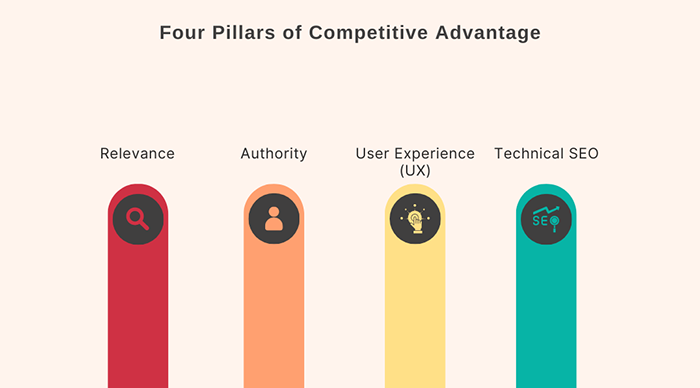
Focusing on these four pillars will not only help you match your competitor's SEO efforts, but can also help you overtake them in search engine rankings.
First, you need to understand who your competitors are. A competitor map will help you identify those players who are driving companies in the market, defining the rules of the game in the industry and can be examples of successful solutions and strategies.
Let's specify the purpose by phoneEvery second, postponing communication with us,
you lose money your company
Get a development plan
Your site!
and site tasks
It all starts with a niche and competitor seo-analysis, which is divided into three parts:
- Studying the target audience (CA) to find out who can be considered the main clients and potential customers. For this purpose, SEO-optimizer analyzes social networks, for example, makes a sample of communities of a certain topic and studies the characteristics of consumers of specific products or services.
In addition, various statistics and analytics services connected to the site can also provide seo specialist with detailed information about interests, age and other information about the CA;
- Immersion in the subject matter of the client's business. Gathering a list of customer «pains», product range and characterization, subtleties and nuances of the services provided. Analyzing popular materials on the topic, including those received from the client;
- Analyzing the main indicators of the site - domain authority, site speed indicator, the number of indexed pages, as well as the presence of mobile applications, the presence of a blog and other possible advantages that add points from search engines to the «piggy bank» of the competitor;
- Keyword research - at this stage it is important to find out what key phrases potential customers use to search for your product, service or infoproduct, as well as competitors. To solve this task, experienced specialists connect such services as Google Keyword Planner, Serpstat, Ahrefs. They significantly accelerate the collection of statistics and analyze data on them;
- Studying the structure of competitors' sites - order and placement of sections, distribution of key phrases and words, content publishing scheme;
- Analysis of content on competitors' sites - how well articles, videos, photos are made, whether they meet the main requests of users, how much such presentation of information is interesting to the target audience in general;
- Study how internal and external seo-optimization is carried out on competitors' sites to understand which donor sites link to competitors' projects and what promotion strategy is chosen in these directions.
When the results of competitor analysis are ready, they are used to develop a SEO promotion strategy, a project work plan and related marketing.
Technical seo-audit: identification of technical problems
At the stage of technical seo-audit checks whether the site complies with the recommendations of search engines regarding the technical parameters of the site. The main task is to identify and correct all flaws and errors, if they can lower positions in the search engine results.
Results of website load speed analysis based on GTmetrix service data
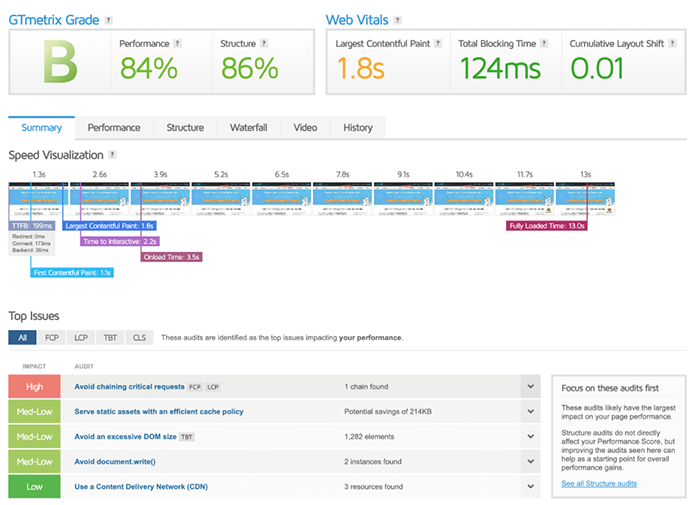
Interesting Facts:
«89% of URLs and 37% of URLs in positions 1-20 rank differently on mobile devices and computers.»
«As of July 2023, 56% of internet searches originate from mobile devices.»
«Compressing images and text can help 25% of web pages save more than 250 KB and 10% save more than 1 MB. These changes reduce bounce rates and increase page rankings in Google search results.»
HubSpot
Technical factors include checks such as
Creating titles and meta tags with automated tools | Automatically generate templates based on pre-selected keywords or their categories, taking into account structural categories, filters, regional location specifics or specific products. |
Creating intuitive and readable URLs | Develop the structure of subpages and sections with human-readable URLs (e.g. /smartphone/brand instead of /sdgqer-2-1), including the use of key search phrases. It is also necessary to define the rules of URL formation for filtered pages and set visibility parameters for filter links |
Optimize the download process to reduce waiting time | Identify and eliminate site bottlenecks that prevent fast loading times. This includes implementing caching systems, using content delivery networks (CDNs) when appropriate, using compression for images and all content, minimizing or asynchronously loading scripts, and optimizing database queries. |
Developing or updating a sitemap | Customize indexing rules for pages that match their desired visibility: activate indexing for key pages and disallow indexing for irrelevant pages. Clear indication of important pages to speed up their validation by search robots. |
Eliminating duplicate content to improve uniqueness and content quality | Configuring redirects for proper traffic management, adding a canonical tag to original pages to determine preferred versions of content, and setting noindex follow instructions to exclude pages from indexing while maintaining link weight. |
Detailed configuration of micropartitioning | Data integration for search engine robots to automatically recognize information about ratings and reviews, images on the site. Also customization of micro markup to generate improved search engine snippets, including displaying categories or contact information for ordering. |
Integration of multilingualism on the website | Set a language switch to allow you to switch to the version of the site in the selected language, and perform site optimization for each supported language. |
Testing the adaptability of the site | Testing the effectiveness of the site on mobile devices, taking into account their priority in search engines. Testing the correctness of displaying important elements such as forms and buttons on a variety of devices. |
Performing regular auditing and debugging of program code | Utilizing scanners and online services to test the site in different browsers and identify errors so that they can be fixed later. |
Conducting an anti-virus scan of the site | Using specialized scanners to check the site for malicious content and then eliminating it if detected. |
Checking the current version of the content management system (CMS) and updating it | Upgrade to the latest version of CMS to prevent exploitation of vulnerabilities of older versions, taking into account that such a transition should not have a critical impact on the functioning of the resource. |
The technical seo audit process checks:
- page load speed - affects the attractiveness of the resource for visitors and seo-ranking;
The PageSpeed Insights API (PSI) allows you to get reports on page load speed on mobile devices and computers, as well as tips on how to increase that speed.
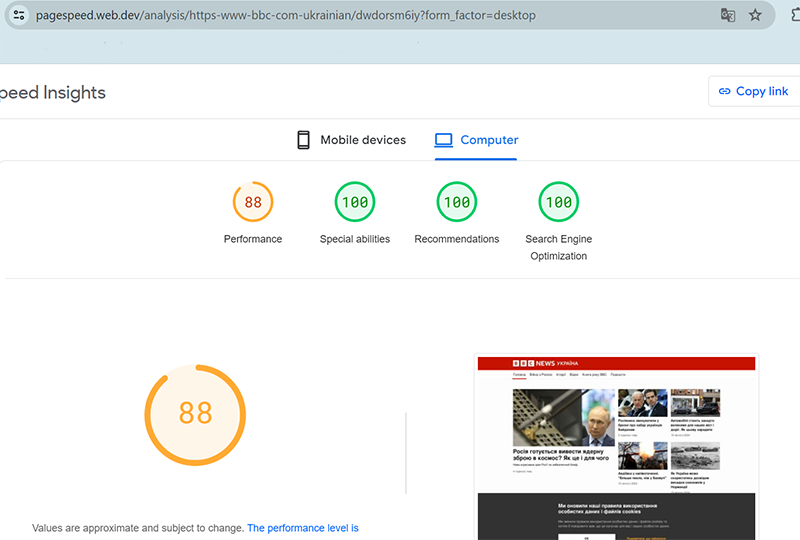
- correctness of the adaptive or mobile version of the site, because today most visitors are already looking for information via smartphone;
- the amount of code and comments in it - long codes slow down the site;
- checking 301 and other redirects;
- presence of the Robots.txt file and correctness of its settings;
- availability and operation of sitemap.xml;
- setting up Schema.org micro markup so that search engine robots can better analyze the data;
- presence and correctness of error 404;
- check for non-working («broken») links - if there are too many of them, it has a bad effect on the ranking of the resource in search;
- check for duplicate pages, they undervalue positions in search engines;
Netpeak Spider website analysis tool checks for more than 100 technical issues. It allows you to filter and segment data, and supports JavaScript rendering.

- check the main mirror of the site, if the resource has several versions, it is necessary that search engine robots saw the main one;
- optimizing «breadcrumbs» for additional navigation and re-linking;
- validation of the program code to exclude possible errors in it.
Technical seo-audit can be done by hand, in which case the percentage of errors identified will be higher, but such work takes a lot of time and effort. With the help of automated tools it will be possible to identify the most common deficiencies, but it will not be possible to fix all the errors. Some important checks are still better to conduct in manual mode, automated systems in such checks can miss important things, which can negatively affect the overall result of promotion.
When the preliminary conclusions of analyzing the target audience, niche and competitors, as well as the technical seo audit have been made, it's time to move on to compiling the semantic core.
Semantic kernel compilation: selection of key queries
Semantic core is a group of keywords and phrases that echo the theme of the project, form the basis of the future structure of the site, and often set the theme of individual pages.
Competent compilation and use of semantic kernel - the basis of the output in the top of search engines.
Interesting Facts:
«Long-tail keywords get 1.76 times more clicks in organic search results.»
HubSpot

Keyword analysis results based on Serpstat data
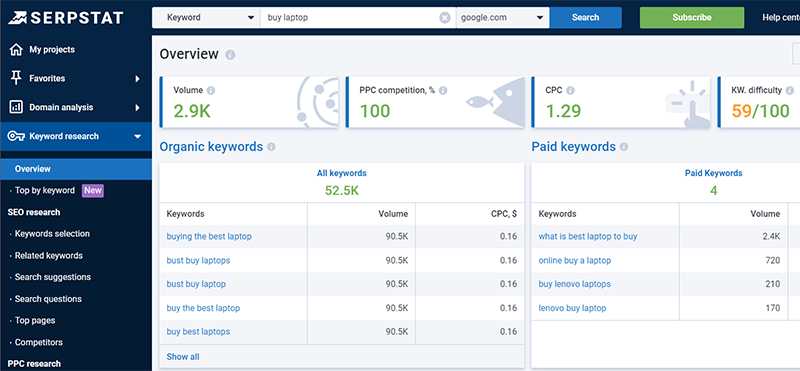
Results of keywords collection in Ahrefs service
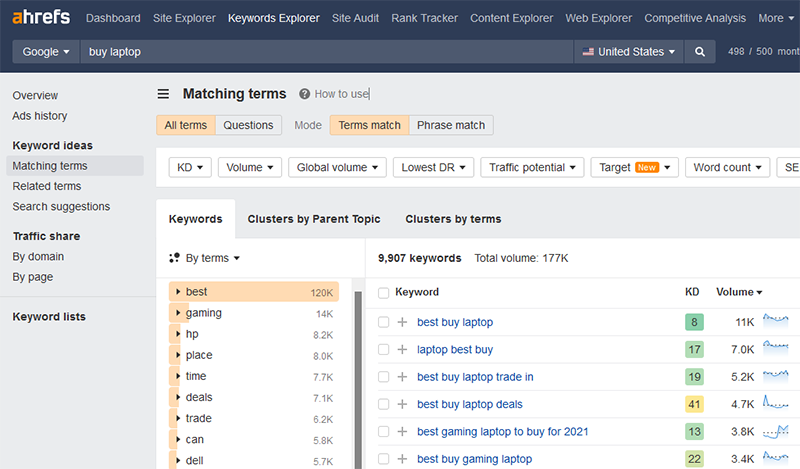
Creating a semantic kernel consists of three steps:
- Collect keywords, it is very important that they meet the goals, the theme of the site and echo the main products, services or other objects of promotion;
- Group the collected keys into partitions and subsections - this process is called clustering;
- Determine relevant urls for each selected query.
And further optimize the pages for specific parts of the collected keyword phrases.
Keyword classification
By frequency of request:
- High-frequency - the most popular phrases that most accurately meet the theme of the site, for display in the top of these keys is the greatest competition, because potential customers often use these words or phrases;
- medium-frequency - everything is the same here, the level of demand for words and phrases remains high, but is noticeably lower than in the previous variant;
- low-frequency - consist of a few words, they are used much less often than the keywords from the previous two points, but such keys are much easier to get to the top.
In addition, almost every site has the opportunity to promote a large number of low-frequency queries. Often it is such phrases bring well «warmed up» buyers who have already determined their desires.
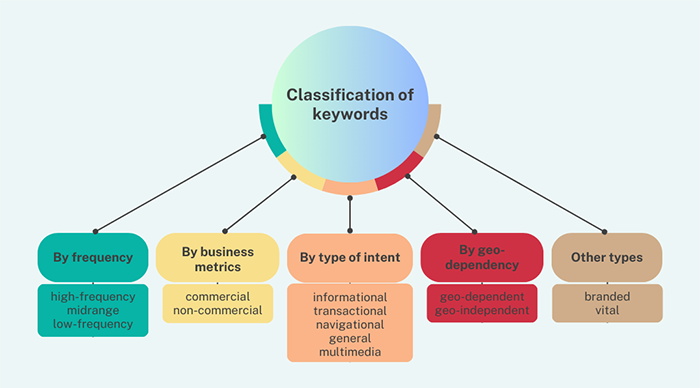
According to the type of request, they distinguish:
Navigation keywords - they help the user to get to the site. For example, a user wants to get to a site he has been to before or heard something about, but doesn't know the exact address. Instead of YouTube, he enters «YouTube» in the search and follows the first link;
Informational keywords - these keywords are used to search for specific information without the intention of taking a targeted action. Such key phrases usually contain the questions «how», «why», «on what principle». For example: «how to choose a washing machine» or «what to do if you get lost in the woods».
Informational queries do not push visitors to a targeted action, but they are also beneficial to business. Therefore, they are actively used in informational posts, articles and blogs;
Commercial key phrases - with their help the user chooses a product or service and in the long term is very likely to buy or order. This group includes feature analysis, testimonials and reviews. For example: «types of plastic windows», «review on iPhone 15», «characteristics of earphones airpods»;
Transactional keyword phrases help the user take a targeted action. For example: «buy a freezer Rozetka», «order a Monobank credit card», «register in TikTok». When promoting commercial Internet resources, such queries are the main focus.
Multimedia queries help the user to search for movies, music or images. This group is divided into three subgroups:
- Branded: «1+1 Online»;
- Informational: «Catch Kaidash 1 episode», «How to make a drone with your hands video», «Stefania, Kalush, full version»;
- Commercial: «Ray Ben sunglasses», «Toyota test drive».
General queries are called so because it is difficult to assign them to one of the above groups. They usually consist of 1-2 words. For example: «dishwasher», «camera», «batteries». A user with such a request has an intention, but expresses it very vaguely. For example: «vacation» - what exactly the user wants when entering such a query in the search box, whether it is to go to Bukovel or to find out the state of the slopes, «alcohol» - to order or to find out the new excise tax, «downshifter» - to find out the meaning of the word or to find out how such people live.
There are other types of keyword phrases besides this, but we'll delve deeper into this topic in another article.
So, why even bother putting together a semantic core in the first place?
A list of the main purposes for which the semantic core is collected:
- form the structure of the site, categorize pages and distribute keys based on the resulting scheme;
- create texts and other types of content for high, medium and low-frequency key phrases;
- write meta tags for pages and include the most popular key phrases;
- form a plan of work with a list of anchors to expand the link mass;
- some keywords can be applied by performing the task of image optimization, which includes not only reducing file size, but also the proper use of keywords to improve the visibility of images in search engines.
Recommendation! Collect semantic kernel should be collected before you start working on the site.
If you do the opposite, there is a high risk that you will not only need to change the structure and order of pages, but also rewrite the content already created.
Preparing a draft site structure for better navigation and indexing
Thanks to the logical construction of all pages and sections of the site, the user understands where the main sections and subsections are located, how to move between pages or return to the main page. Clearly thought-out structure is easier to understand search engines, which allows them to unmistakably recognize the theme of the site and varieties of goods or services.
Proper website structure = effective SEO promotion
Proper site structure = fast site crawling by search bots = fast site indexing

Interesting Facts:
«If your site is not indexed by Google, it is virtually invisible. It won't show up in search results and get natural traffic. At all. At all. Nothing.»
https://ahrefs.com
When the semantic kernel is already worked out and has a final version, you see all the key groups divided into subgroups, the future structure should already be drawn out. To fix everything, do not miss anything important and easily make adjustments, it is recommended to convert the entire structure into a scheme, for example, using the service mindmap.
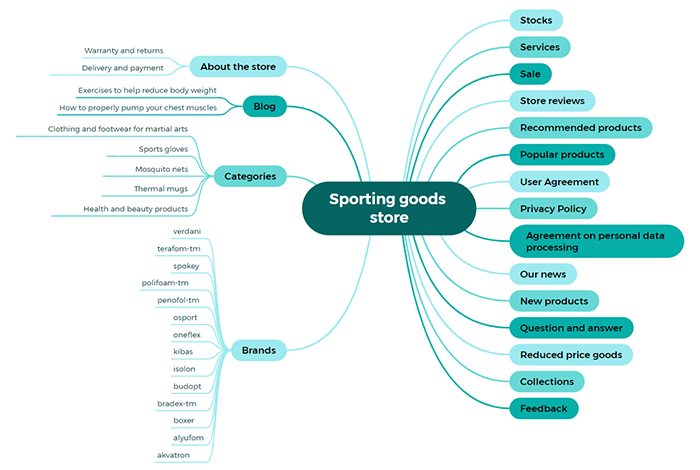
When building the structure is also important to use logic and understanding of the psychology of users in their behavior on the site to create a convenient navigation and maximally simplify and speed up the search for the desired product, service.
When compiling the structure, you should definitely pay attention to the level of nesting of pages.
The nesting level of pages is their position in relation to the main page. Nesting is counted in clicks. The distance from the main page to the main sections can be one click, and to subsections or sections with products two or three clicks. For example, for an online store optimal level of nesting three clicks. Such a site is convenient for visitors to interact with and search robots will definitely like it.
The standard hierarchy consists of pages of several levels. On the first - the main page and main categories, on the second - subcategories and so on to the end, depending on the specifics of the project.
A hierarchical structure helps you navigate faster and find what you need.
If we imagine that we are looking for a child's bicycle, the path to it will be like this:
- Home Page;
- Baby Products;
- Means of transportation;
- Bicycles;
- The product card of a particular model of bicycle.
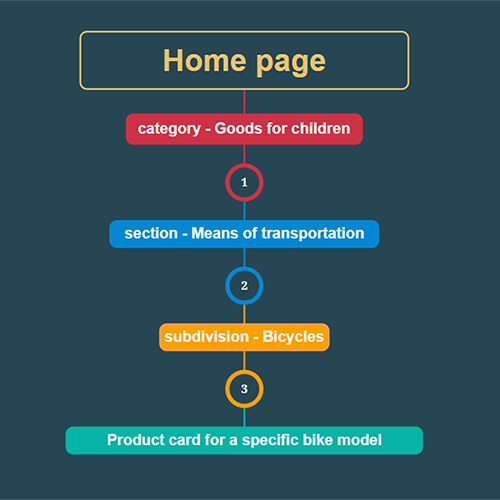
Under this scheme, you need to make only three clicks to get to the product of interest that the visitor needs. This is relatively small and simplifies interaction with the online resource.
But this example can not be called universal, because the structure of the site is determined by its goals. Based on them you can choose one of the schemes, and the essence of each of them we will consider below.
Alphabetical structure - all sections and subsections in alphabetical order. It is suitable for dictionaries, encyclopedias and large catalogs, for example, on marketplaces. When choosing such a structure for commercial projects, it is necessary to realize that the client knows what letter the product is called by and will be able to find what he needs alphabetically.
Chronological structure groups user requests by date. It is suitable for news sites and projects that publish a large number of press releases. Here it is important to be sure that the visitor at least roughly understands in what timeframes it will be possible to find the information he needs.
Geographic structure - it is suitable if it makes sense for the project to decipher location-based information. For example, it can be a resource that collects data about stores, enterprises or medical institutions in the context of cities and regions. This structure is suitable in rare cases, because not all visitors are well versed in the geography of even their own country.
The thematic structure is considered to be the most common, it is used on informational sites and almost all types of commercial projects. Information is grouped by topics and categories. This approach helps to quickly navigate the menu, and everything you need is often within one or two clicks.
Structure for target audience - focuses on specific groups of potential customers or event participants. This option is considered user-friendly and user interaction with the resource. For example, through additional features, design or menus adapted to specific categories of the target audience.
The structure by tasks builds a menu of important actions for the user, which are divided into separate categories and subcategories. This option may be appropriate when designing a resource for the service industry. For example, sections on the site of a beauty salon can be called: «make styling», «dye hair», «sign up for a manicure». With the right choice, this approach makes life much easier for the user.
Metaphorical structure is necessary for sites of narrow specialization. Metaphors should be understood as symbols, maps, schematic images that cause the right associations. For example, on the site on horoscopes information can be grouped by zodiac signs. And each section can be labeled schematically, by clear images of Sagittarius, Lion, Cancer and so on. Such a structure is beautiful, but it is considered ineffective for SEO, so it is rarely used for promotion.
Hybrid structure - a combination of several ways of organizing information. It is needed to create specific conditions for the target audience. It covers large layers of information and simplifies interaction with projects. For example, when combining the structure by tasks and groups of the target audience, you can think of interesting categories in the connection of the name of the profession + tasks performed by this or that specialist.
Filling pages with content: creating unique and valuable materials

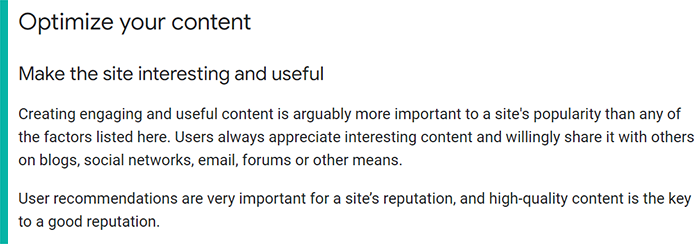
They say that content is king. Texts are the basis of SEO promotion in any format and regardless of the chosen approach. Without unique, interesting and useful content, promotion of an Internet resource by keywords is basically impossible.
«This means that uniqueness is crucial. You should strive to create engaging content that offers valuable information, practical advice and fresh perspectives.Try to think of yourself as a thought leader in your industry.
What topics are not covered on other sites?
Or can you do a better job of covering the topics they've already covered?»
Author: Brian Dean, seo specialist, founder of backlinko.com
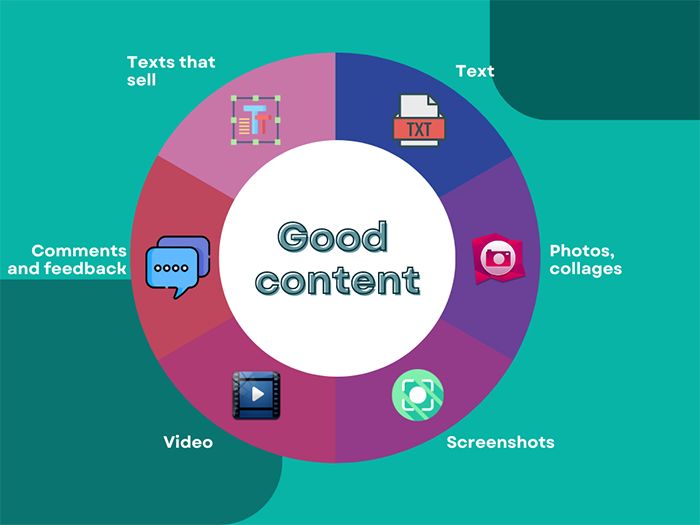
How do you work with content to make visitors love your site?
- Bid on the presentation of your personal knowledge and experience. Talk about everything, often failures are even more interesting than successful cases. Share in detail everything you know how to do, for example, new techniques and skills in your work that you have recently mastered;
- Try not to rewrite texts from similar companies - this will definitely affect the promotion for the worse. Make the quality of new material for publications a top priority;
- Think about usefulness - write how you solve problems with clients, with government agencies, with partners, contractors. Any really useful and unique information will work for the growth of all the main indicators of seo-promotion;
- Don't forget about humor and creativity - today competition is high in almost any niche, which means your content should be funny, entertaining, stand out and attract attention.
Don't focus on any one way of communicating with your visitors, use all available types of content.
This is more convenient for your target audience and better for promotion:
- articles - here we write strictly on the subject of the site, cases, narratives, stories from the life of the company, but the description of basic offers must have;
- video is the most popular way to transmit information, so today you can't go anywhere without videos, entertain, explain the complicated, show the incomprehensible - users will appreciate any live presentation of information;
- infographics are convenient, useful, clear, bright and eye-catching, and they also help simplify, summarize and quickly explain complex things in simple language;
- blog posts are a quick way to communicate with your target audience, ideal for news about new products, promotions, and any topic that unites your target audience around your company.
When at least some of the content is ready, its main elements are linked together to simplify navigation for users and search engine robots. This is called internal linking, and we'll talk about it next.
Internal relinking: linking between pages

In the process of relinking, pages are linked together using hyperlinks. Internal relinking helps search engine robots to index all pages faster and understand how well the structure of the Internet resource has been worked out.
Here are some useful guidelines for organizing internal re-linking:
- link similar pages to each other, for example, a case study page can link to the next and previous example of client work;
- pay attention to important pages - it is almost mandatory to have links to the main categories of products or services on the homepage;
- use natural links and remember that this is the only right way to work with them, each link should look organic and relevant otherwise there will be problems;
- check internal linking regularly, add new links as additional pages become available, test whether the links previously placed are working correctly.
Here are examples of internal relinking that work effectively on modern websites:
- In the «basement» of the site (footer) place links to contacts, blog, news, as well as all the important sections and subsections. Sometimes even the things that do not fit in the «header» (header) of the site are shown here;
- Breadcrumbs make it easier for the user to navigate the resource, show where a person is at the moment and in general work well as a means of internal re-linking;
- Menus are the main means of internal re-linking, and should be given a lot of thought in order to maximize ease of navigation and shorten the path to the most important information for the user;
- A list of related products or services will also serve as a good guide to important sections, subsections of the site or product cards;
- Lists of products to collect a set, collection will also help to implement additional internal linking on the site, for example, it may be appropriate for online jewelry stores;
- In-text is the most effective way of internal re-linking, it helps the user to quickly navigate to similar pages of services or products, additional content on the topic is engaging, increases the time spent on the site and helps to convey more information to the potential customer.
External optimization: strategies for gaining external links and authority
External optimization, aka linkbuilding is needed to get links from sites that have a high ranking according to search engines. Such links help the resource to rank better in search, to gain weight and authority faster.
There are five main linkbuilding strategies known to work today:
- links from other sites, as a rule, with a slightly higher rating than yours, you can agree on mutually beneficial terms, and sometimes such gestures are made simply to support a promising project;
- links from social networks - the more often visitors share your content in social networks, the faster the trust to the resource will grow in the eyes of users and search engines;
- guest post with quality content - a great way to interest the owner of a reliable resource to exchange links, the main thing is not to go beyond the boundaries of their topics and stay true to the interests of the target audience;
Potential partners for getting quality links can be found in thematic groups of any social networks or on forums related to the activities of your project.
But quality content decides the most - really useful and necessary materials are gladly reposted by unfamiliar users and even entire companies, the main thing is to make sure that the authorship is preserved.
In order for search engine robots to consider your external links as quality, try to interact with similar online resources or sites that resonate with the activities of your project.
Seeking to mine links from different sources, only social media or only guest posts is a bad strategy that will slow down the active and successful ranking of the site.
Analytics. How to track the result of the work. What tools and reports are available

Dashboard of Google analytics website visitor statistics service: traffic attraction report
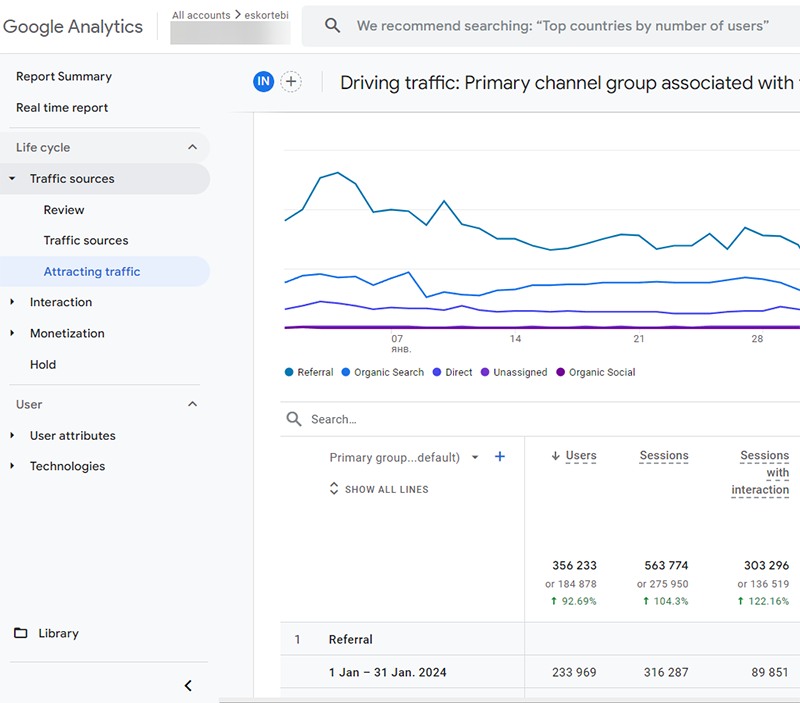
Dashboard of Google analytics website visitor statistics service: summary of reports
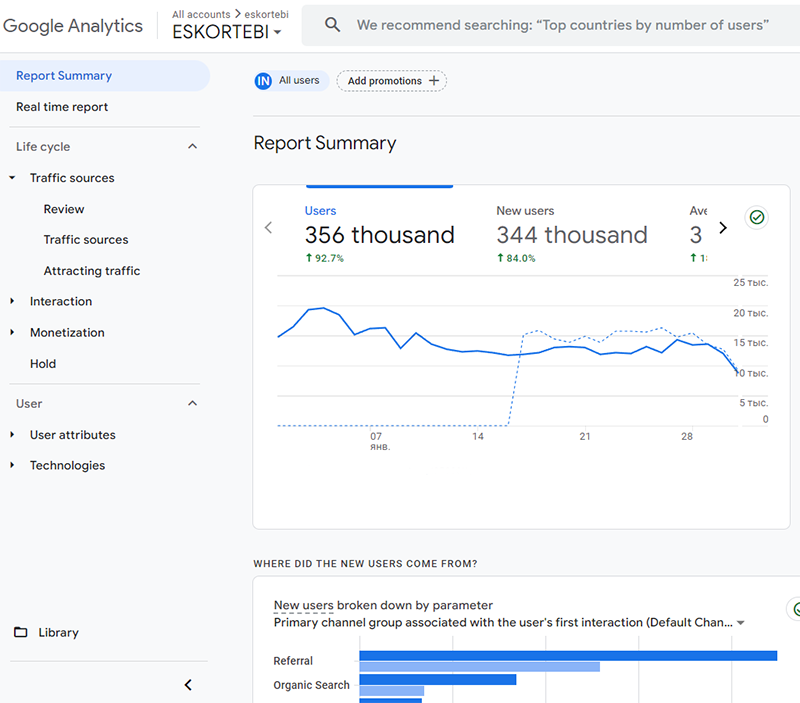
«It's impossible to put a high priority and get approval for your SEO tasks without knowing what works and what doesn't work for your site.»
Author: Michael Duggs, specialist ahrefs.com
«SEO analytics is the process of collecting and analyzing raw data to facilitate decision making about your search engine optimization efforts. It helps you prioritize tasks, get approval for SEO projects, and make better decisions to improve your SEO.»
Author: Michael Duggs, specialist ahrefs.com
In order to analyze the results of SEO-promotion and generate reports for a selected period of time as accurately as possible, it is recommended to master the work with such tools:
Google Analytics - completely free, helps you track traffic, its sources, behavioral factors and many other important seo indicators;
Google Search Console is a free tool for analyzing the process of indexing in search, helps to track changes in keyword positions, fix errors, in addition, there are a lot of other useful features;
SEMrush is a paid tool with a comprehensive set of functions for seo-optimizer, with its help analyze competitors, keywords, backlinks and other seo-indicators;
Ahrefs is another good paid tool, very similar to the previous one. Which one to choose is a matter of taste, perhaps you will like the interface here better;
Majestic is a good paid backlink analysis software.
If you thoroughly dig into these services and learn to analyze your SEO projects with their help, it will be more than enough for most tasks and goals.
The final stage of promotion is to increase conversion. Here we are talking not only about sales and transformation of a visitor into a buyer, but also the fulfillment of other promotion goals.
An example of a standard intermediate goal is subscribing to a newsletter for company news, updates and promotions. It is at the stage of increasing conversion that the most successful bundles of content, design, testimonials and calls to action are determined.
What SEO reports we provide to clients
Everything depends on the chosen tariff, but it is more convenient to present the main types of reports in the form of a list:
- the results of a comprehensive seo-audit with 100+ important parameters that are responsible for the results of seo-promotion, with recommendations and technical tasks for specialized specialists;
- reports on traffic and positions 2 times a month with clear conclusions, explanations and recommendations;
- daily!!! reports on the work performed according to the work plan agreed with the client. The client is always aware of what we do. At any moment, wherever our client is, he can monitor the process of work and most importantly evaluate its result.
We also conduct:
- usability analysis;
- behavioral factor analysis;
- comprehensive competitor analysis;
- cross-browser analysis;
- report on company registration in catalogs;
- a report on the work with link mass.
And that's just part of the list of major reports, not counting the interim ones.
Naturally, we at Jobstudio do not limit ourselves to providing the client with reports as such. Together with detailed analytics in electronic or printed form, we provide detailed explanations for each group of collected data that you will see in the reports, and you can also familiarize yourself with new, perhaps not quite clear terms and abbreviations.
The personal manager who accompanies the project will explain the results recorded in the report in a simple and understandable way. They will also tell you what work is planned to improve the results achieved.
Types of SEO optimization
Modern webmasters are focused on working with white promotion methods and only occasionally abuse gray schemes. Although some individual specialists and even companies still resort to prohibited black optimization at their own risk. It gives fast results, but also quickly turns into severe sanctions from search engines.
Types of approaches to SEO by degree of legality: white, gray and black optimization
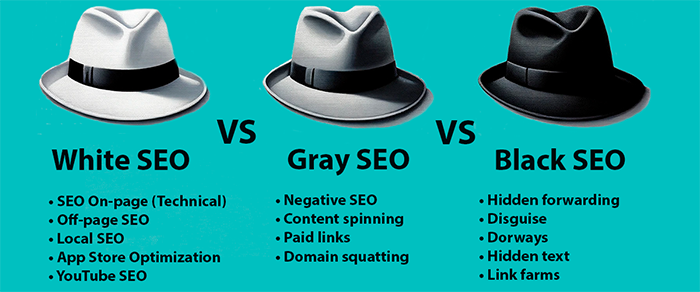
How do the three well-known SEO promotion methods differ from each other?
White methods are all actions according to the recommendations of search engines. Working in this direction, the project is not threatened by sanctions and if you do everything correctly, you can achieve good results.
This includes optimizing content for keywords, internal re-linking and placing natural links.
Gray methods:
- manually created dorways (dorway or entrance page is a web page specially optimized for a specific query or group of search queries) with relatively high-quality texts for specific queries, the purpose of dorway - to transfer weight to the main resource;
- buying links from social networks, it is desirable to work with authoritative accounts and do it regularly;
- mutual exchange of links, preferably with resources of similar topics, when using this method outgoing links will take away weight;
- guest posting in authoritative blogs on the subject of the site with maximum natural links;
- Satellite sites to displace competitors and maintain the main resource;
- posts on thematic forums with links to the object of promotion, with regular use improves the quality of the link profile;
- texts on the edge, with maximum keyword occurrence on the edge of the acceptable level of 4-5%;
- purchasing links on proven exchanges of eternal links and authoritative sites, here it is important to build up the link mass correctly and form a natural link profile.
Black methods are a direct violation of search engine recommendations. If caught red-handed, you can get an eternal ban in a second and disappear from the search engine forever.
The most gross violations are considered to be severe overspamming, buying unnatural links in large quantities, stealing other people's content, as well as the use of hidden images or text, content substitution*.
*Content substitution, aka hyper-segmentation, aka personalization - showing visitors unique offers based on personal data collected about them. For example, a person from a particular city wants to buy a smartphone of a particular model, goes to the page and sees just such an offer.
Do not resort to black methods in pursuit of a quick result, as the effect of them in any case will be short-lived at best, and at worst - the site will forever be under the sanctions of search engines. Leave it to unscrupulous SEO specialists and spammers.
To successfully grow your business and make profits - contact honest «white» professional SEO promotion specialists.
Do you want to increase sales of your goods or services every month without the risk of being penalized by search engines? JobStudio team has been successfully promoting websites for many years. We use only authorized white promotion methods that will help your business grow and develop, taking into account its peculiarities and budget size.
Criteria for success of SEO promotion
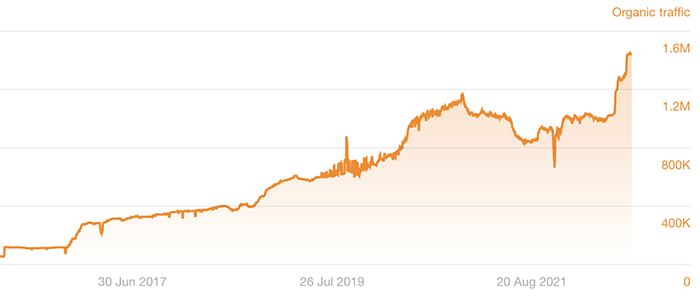
It all depends on your goals, but in order of priority, the criteria for success look like this:
- The growth of positions in search, entering the top of the output for key queries important for business - this indicator determines the visibility of the resource for users. Such an indicator as visibility for queries that bring the main sales is especially valuable;
- Increasing the volume of organic traffic - the more visitors, the better. In this case, it is important to understand that it is the target audience of the resource that should come to the site, trivial traffic spoofing will not benefit the project;
- Conversion growth - if those who come to the site, buy, order, register, it means that you are collecting quality «warm» traffic. It is very important that the conversion rate is constantly growing. To analyze it, they consider what percentage of visitors move to the category of buyers;
- Increasing brand awareness. It is convenient to analyze the growth of branded traffic in Google Analytics by the number of clicks on branded queries.
The main criteria for selecting KPIs for promotion are:
- internet project goals;
- planned conversions;
- period of analysis and regularity;
- the labor intensity of data acquisition;
- the possibility of obtaining concrete data in figures.
What results should you expect from SEO? Timeframe to reach Google top 10
The average age of pages that are in the top 10 of Google is about two years. And those pages that occupy the highest positions in the top, right after advertising, exist, on average, three years. And only a little more than 20% of the pages in the top ten get there during the first year of life.
If a young page is created according to all the requirements for modern SEO promotion, it will be enough to 2 to 6 months to appear in the top 10 of Google.
Provided that we are not talking about the most competitive and «overheated» niche. For example, an online resource that sells cell phones or plastic windows in Kiev to solve such a problem will take more time.
Relatively accurate terms of getting to the top of Google with a link to the types of key phrases and the age of the site is easiest to present in the form of this table
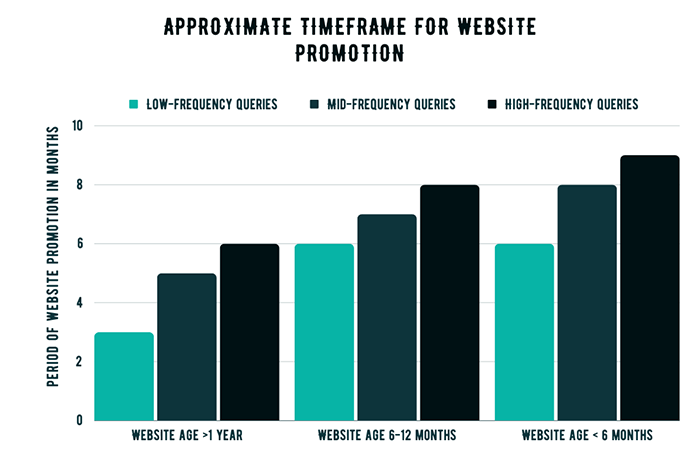
It is important to realize that the percentage of young pages that appear in the top 10 is, on average, relatively small. While 95% of all new pages on the web do not appear on the first page of the output even during the first year of life. Too much in this case depends on the skill of the seochenist or the team that is engaged in seo-promotion.
Interested in how much does it cost SEO to promote a website to the top 10?

Is your goal to get your site into the top 10 search engines in a short period of time? Are you interested in attracting only the target audience with the help of «white» promotion?
Order turnkey website SEO at JobStudio - and we will help you solve each of your tasks with an optimal budget.
And our tariff plans can be found below
«Basic» |
|
| |
Couldn't decide on a tariff?
Fill out the form and our managers
will consult you today
How does AI help in seo promotion?

Interesting Facts:
«70% of web analysts and search engine
optimization experts say the new artificial intelligence-enabled search will encourage people to use search engines more often than before.»
Artificial intelligence is already automating simple routine tasks, such as selecting and grouping keywords, analyzing competitors, and generating reports.
In addition, AI helps to improve the accuracy of data analysis and make better decisions when developing an SEO promotion strategy.
AI also predicts SEO trends, which helps webmasters make more accurate predictions and stay ahead of the competition. AI also helps automate project management processes in SEO promotion.
«Experts believe that how-to/question-and-answer content and review/comparison content will work best when generative artificial intelligence is incorporated into search engines.»
«50% of U.S. consumers use voice search on a daily basis.»
HubSpot
Let's take a look at how AI really helps SEOs using ChatGPT as an example.
Here are the specific tasks that the neural network is already performing today:
- Conducts basic keyword searches;
- Generates low-frequency keyword phrases with «tails» which are longer and more specific variants of search queries;
- Identifies LSI queries (LSIs are words and phrases related to the main query semantically, in meaning, not limited to synonyms only);
- Clusters keywords;
- Classifies key phrases by intent (intent is the purpose of the user's search query, the reason why the user entered the main query into the search);
- Conducts text rewriting;
- Generate topics for articles;
- Creates the structure of the articles;
- Creates briefs for writing articles;
- Generates meta tags.
And these are just some of the dozens of tasks available. Of course, despite ChatGPT's extensive capabilities, it is still too early to talk about the complete replacement of the webmaster by artificial intelligence. The neural network is still far from perfect and makes gross errors when performing most tasks.
Conclusions
SEO optimization is a mandatory type of promotion for all commercial and non-commercial projects that have more or less serious competition in their segment.
SEO makes it possible to get quality traffic from search and repeatedly recoup the funds invested in seo-promotion. Successful work SEO-studio can bring large volumes of traffic for years and even decades. Of course, search engine seo-promotion is not a panacea, but it is definitely one of the foundations of a modern strategy for the promotion of Internet resources.
FAQ
What's more effective SEO or Google ads?
These tools are too different to compare them as equivalent ways of promotion. SEO is a long game with a lot of time and effort. On the way out we get free traffic of very high quality for many years.
Contextual advertising has a number of disadvantages:
- requires a lot of expense;
- it is very easy to waste budget in case of illiterate customization;
- applications often turn out to be overpriced;
- traffic stops immediately after the ads are turned off.
Does it matter who does seo promotion freelancer or studio with experience?
Freelancers too often stop contacting you or abandon a project without warning. Such specialists have no transparent reporting, no clear work plan, and often no contract. The only plus of choosing a freelancer is the cheapness of services. But against the background of all the disadvantages, this advantage looks very doubtful.
A studio with experience means maximum transparency at all stages of work, detailed reporting of results, optimal prices, good speed due to the fact that several specialists are working on the project at once, higher level of expertise, efficiency, financial guarantees and absence of risks.
Is there a pay-for-performance SEO?
Yes, of course. For example, we at JobStudio have a «Rational» tariff with payment per attracted lead. Payment is possible for applications, orders, calls, registrations and other targeted actions.
How do search engines evaluate websites and determine their relevance?
Usually take into account the quality of link mass and content, technical condition, as well as analyze behavioral factors. In addition, it is important to consider the age of the site and domain. Search engine algorithms are constantly improving and over time the requirements for all four areas of evaluation are becoming more stringent.